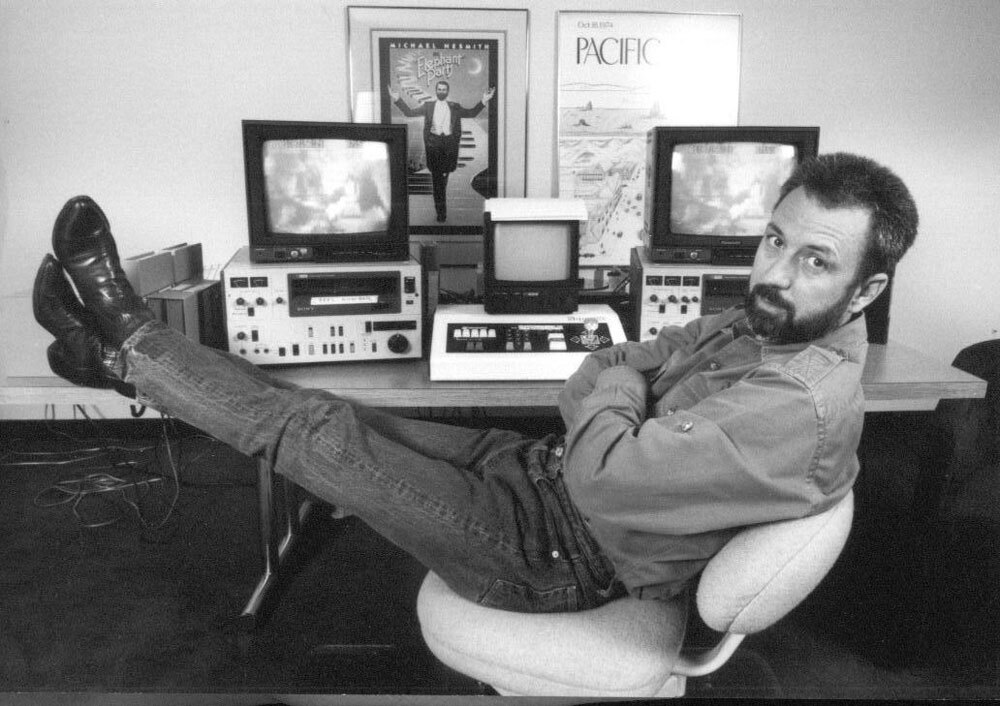Today in Tedium: Like much of my New England-bred elder millennial cohort, I first saw The Monkees as part of an afterschool cartoon block on local UHF station WLVI-56. Unlike much of my cohort, I hated it. The songs were cloying, and Micky and Davy’s toothy grins and loud, sing-songy speaking styles reminded me of the teachers in my special ed math class who talked down to me because I was a little behind in arithmetic. Since the other kids in my neighbor’s babysitting group loved the series, however, I had to get through it to see the Bugs Bunny cartoons I adored. I began to identify with the rangy, plainspoken guy in the green wool hat whose sarcastic asides and stoic, slightly irritated facial expressions suggested that he didn’t want to be here, either. Little did I know that the guy in the hat would be my Virgil, guiding me through pre-gentrification Downtown LA in a series of influential feature films. In today’s Tedium, I’m exploring Mike Nesmith’s second act as a film producer and distributor. — Chelsea @ Tedium
Today’s GIF features Nesmith starring with John Cusack in Tapeheads.
Are API keys or other sensitive data in your logs?
Learn how to find out what you are logging with Nightfall’s Developer Platform and our new Fluent Bit filter plugin here.
Nesmith’s “Rio,” considered one of the first music videos as we think of them today.
The other legacy Mike Nesmith left on popular music
When Mike Nesmith passed in late December, his fans mourned a unique and innovative talent. For many boomers and beyond, the TV show The Monkees played a formative role in shaping their musical interests. Nesmith was one of the first actors to play a rock musician in a TV show, and the original songs he wrote for the band were among the most innovative and memorable to appear on the show. After leaving The Monkees, Nesmith recorded a string of country-rock albums that made the psychedelic country music trend of the mid-1970s more accessible to mainstream audiences.
His career took a turn at the end of the decade. After shooting a short film to accompany his single “Rio,” Nesmith is thought to have coined the term “music video.”
“Rio” includes a statement from Nesmith’s Video Ranch production company about the production of the “clip” (as he would call it): “While editing, director Bill Dear and Nez discovered that music can take over the narrative to create continuity even when placed over discontinuous images.”
The song fell short of the Billboard Hot 100, but the clip earned enough acclaim among his music-industry peers that he thought there might be a demand for a 24-hour music video station. When Warner Amex CEO John Lack saw a pilot for a music video show called Popclips that Nesmith wanted to produce, he agreed; Nesmith sold the idea to Lack, and it went into production under the name MTV.
“The word ‘invent,’ it’s inapt,” Nesmith said in I Want My MTV, expressing skepticism towards the idea that he created the station. “It’s a gradual coalescence of different things, a confluence of energies. It’s one of those ideas that nobody really thinks up.”
His work on MTV—as well as on a sketch-comedy project called Elephant Parts—gave him some cachet in the film and TV world, and he began producing and distributing movies under his Pacific Arts Corporation rubric. The three films he executive produced—Timerider, Repo Man, and Tapeheads—took the surreal blend of music and comedy that his mentors Bob Rafaelson and Bert Schneider made popular on The Monkees and updated it for an audience weaned on music videos and Saturday Night Live.
The feature films Nesmith produced in the 1980s are still beloved by midnight movie enthusiasts, both for their irreverent humor and for their whimsical depictions of pre-gentrification Downtown LA. While Nesmith’s involvement with these features is a badly kept secret, his work on producing these films and helping them reach a wider audience is consistent with his idiosyncratic creative output.
1980
The year that Mike Nesmith first worked on PopClips, the groundbreaking program that was one of the earliest ways many people saw music videos. The format, which aired on the cable channel Nickelodeon, was soon reworked into a full-on network based on Nesmith’s idea—MTV, which launched in 1981. Nesmith felt that the idea, once Warner adapted it, became watered down. “The marriage of music and images in a short form, and I guess we have to call that ‘music video,’ really has not been realized yet,” he told the Los Angeles Times.

Nesmith, as an executive with Pacific Arts in 1988. (Henry Diltz/via Monkees Live Almanac)
How Mike Nesmith’s film work extends his work on The Monkees
The first film Nesmith produced had its roots in his previous project. After working with director William Dear on the acclaimed sketch comedy/musical hybrid Elephant Parts, Nesmith cowrote the screenplay for Timerider: The Adventure of Lyle Swann with Dear about a time-traveling motorcyclist. He would eventually produce the film, which premiered in late summer 1982.
Timerider seems like an outlier in Nesmith’s filmography. Of the three films, it’s the most plot-driven; the story follows a competitive motorcyclist who rides through a hole in the space/time continuum and has to contend with Wild West clergy, grubby thieves, and sexy babes before returning to the 1980s desert where he belongs. The ambling-but-insistent pacing is a big contrast with Nesmith’s later efforts, which moved their characters along with episodic structures and flashier editing.
Like his later productions, Timerider has an irreverent sense of humor, and Dear’s use of western tropes and fish-out-of-water cliches has an appealingly self-aware quality; after a while, the repetition of the line “where’s my bike” goes from annoying to hilarious. While Timerider wasn’t the cult hit Nesmith’s later films were, it plays like the kind of movie you’d be happy to see on basic cable on a Saturday afternoon.
Nesmith’s Pacific Arts production company made a $5 million profit on the modestly budgeted Timerider, which gave him a nice financial headwind as he went into his next film. He was one of 200 producers to receive a package from then-recent UCLA film school graduate Alex Cox that contained a script and a comic-book pitch for the punk rock feature film Repo Man. Unlike the 199 other recipients, Nesmith connected with the script, which he described in a 1982 interview as “a scan across the American psyche.” A meeting with Cox and his cohort gave Nesmith the confidence to sign on as Repo Man’s executive producer, putting up his own money to cover the initial cost of making the movie.
The seedy characters, down-at-the-heel locations, and razor-sharp satire of Repo Man was a 180-degree departure from the amiably subversive comedy of The Monkees. Watching the film now, though, viewers can see some baseline similarities between Nesmith’s earliest gig and his most popular movie. Repo Man has a plot—several disparate DTLA cliques, including a conspiracy theorist, a well-off UFO enthusiast, a group of punk teenagers, and two rivaling repossession agencies pursue a Chevy Malibu with a mysterious object in the trunk—but the film’s episodic structure and cast of eccentric characters shared The Monkees’ frequent lapses into hangout-movie looseness. Similarly, the soundtrack of scabrous LA hardcore bands couldn’t be further from the Monkees’ proto-power pop sides, but Cox’s ability to tap into the musical zeitgeist matched that of Nesmith and the music supervision department of The Monkees.
The soundtrack for Repo Man saved the film from death by basic cable. Universal agreed to distribute the film on a negative pickup, but by the time Cox turned it in, there had been a regime change at the studio and no one knew how to market the film. After a successful screening at the Berlin Film Festival, Repo Man opened on fewer than 40 screens and made $95,300 dollars in its first weekend. The soundtrack, meanwhile, had become a surprise hit with punk-starved young listeners, and Universal re-released the film after the album sold 50,000 copies. Repo Man would eventually make a small return on its investment, and both the director’s cut and a bizarre made-for-TV edit became classics in the punk film canon.
If Repo Man drew on The Monkees’ legacy of shaggy pacing and a murderers’ row of character actors, Tapeheads—Nesmith’s final effort as an executive producer—updated the series’ sunny subcultural satire for the MTV era. Josh Tager (Tim Robbins) still lives with his parents, where he remixes Super-8 home movies and dreams of becoming a filmmaker. When he loses his job as a security guard, his friend Ivan Alexxev (John Cusack, playing against type as a pencil-mustached creep) talks him into realizing his dream of filmmaking by opening a music video production company. Neither of them seems to have any idea what they’re doing, however, and after their first big-name music video shoot ends in tragedy, the video is put into high rotation at the music television network RVTV … setting the stage for Josh and Ivan to give their heroes, the R&B duo Swanky Modes, a major comeback.
Josh and Ivan’s hapless characters would be at home in an episode of The Monkees—a show in which the title characters struggled to get gigs and work with record producers—and the plot comes off as a macabre twist on a typical Monkees episode. Until the last 15 minutes or so, the plot of Tapeheads seems like flimsy scaffolding that director Bill Fishman uses to hang some hilariously terrible fake TV commercials and music videos, which showcased Josh’s actual filmmaking talent in a similar way to how the Monkees’ musical numbers gave us an idea of the band’s actual talent.
$133k
The amount of money Tapeheads made over opening weekend. According to the American Film Institute, the film’s distributor, Avenue Pictures, pulled Tapeheads from distribution and pivoted from a “hip and selective” ad campaign to one that emphasized the broader comedy in the film. Sadly, a new ad campaign didn’t improve the popularity of Tapeheads, and it left theaters having made less than $1 million at the box office.
While Nesmith’s creative legacy was bolstered by his work in film, his bank account, unfortunately, was not.
In a 2016 profile at the Dallas Observer, Nesmith noted that working within the film industry left him “in tatters”. A year after Tapeheads bombed at the box office, Pacific Arts Corporation was embroiled in a lawsuit with PBS, and Nesmith pulled back from movie and TV production.
“It’s a tight-wire across the Grand Canyon every time you walk it,” he told reporter Jamie Laughlin. “If I was in Truffaut’s France I might still be making films—but I wasn’t, and I’m not.”
While Nesmith focused more on music and on his VideoRanch projects in the last decades of his life, he was able to bring the legacy of The Monkees to independent and cult film. You could draw a straight line from Tapeheads to the gleefully anarchic fare of [adult swim], and Repo Man’s lacerating satire of Reagan-era America and its depiction of underground subcultures would pave the way for movies like Heathers. In his autobiography Infinite Tuesday, Nesmith downplayed his production work by calling himself a “Hamburger Movie Mogul,” but his influence has carried him further than he might have expected.
--
Find this one an interesting read? Share it with a pal! Thanks again to Chelsea for taking part.
And thanks again to Nightfall for sponsoring this one.





